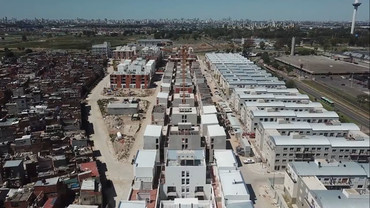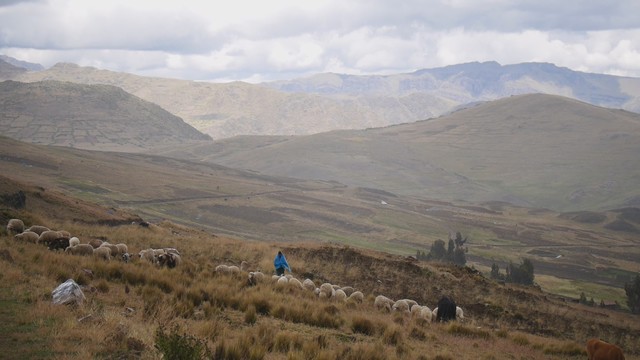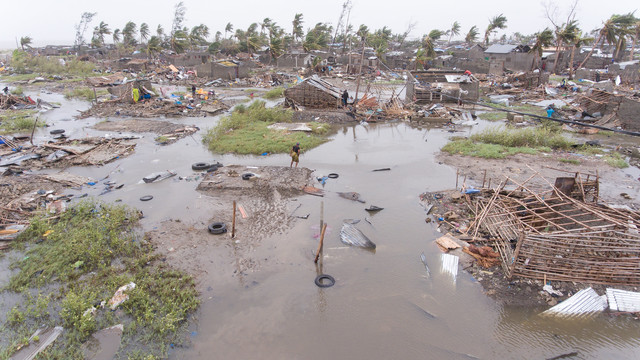How can local urban priorities connect with responses at global level to the climate crisis?
Following a visit to Naucalpan on the fringes of Mexico City, Rosalind Goodrich reflects on the challenges of connecting priorities that are inherently local with global responses to climate change.


The overgrown railway track is part of a regeneration plan in Naucalpan, Mexico (Photo: Rosalind Goodrich, IIED)
Naucalpan, on the edge of Mexico City, is an ancient place. Between 1700 and 600 BCE the Tlatilico people settled on the edge of the River Hondo; many centuries later the Mexica people, part of the Aztec Empire, were there – until 1521 when the Spanish took control.
Today, it is a city of 800,000 people; an old industrial zone where the car is the most dominant force and the River Hondo has been deadened by waste.
Naucalpan is one of the five focus cities of the Transformative Urban Coalitions project (IKI-TUC) in Latin America, a project that wants to make sure climate mitigation efforts are underpinned by equitable development and social justice.
It has people at its heart: some who are concerned to change the urban environments they live in to improve their quality of life, others who are intent on reducing their city’s CO2 emissions. Ways of doing this vary: making it safe for everyone to walk and cycle, building a sustainable public transport system and housing supply, or creating more open public space with trees and vegetation.
I visited Naucalpan recently and as I walked round the streets and looked over the river’s grey cloudy water, it was hard to picture how that transformation would take place.
What would happen to the people living in informal housing by the river – some in old railway carriages by a disused track (earmarked for renovation as part of the regeneration plan)? The local authority wants to build new housing for 200,000 people – but as much for people coming in from surrounding areas as people made homeless when areas are cleared.
And how long would it take? The ambition of a new light railway taking commuters into Mexico City seemed many years away.
But already, in every city of the project, residents, local civil society organisations, researchers and municipal authorities are coming together to work out their priorities for transformation.
Making connections
This project starts at the local level and everything I saw in Naucalpan illustrated the challenge of making change happen. City residents from Buenos Aires in Argentina to León in Mexico, had identified food, better housing and jobs as most urgent; for them climate change was a longer-term problem, which they struggled to prioritise.
Yet at the global level the conversation is about the climate crisis, of mitigation and adaptation, of loss and damage; of cities being the centre for achieving net zero.
How can these priorities be connected? One communications initiative already under way is a photo competition: people have been asked to send photographs responding to the question ‘what makes a sustainable and desirable city?' The winners and a selection of other images will be displayed outside the Action Hub at COP27, accompanied by a short written piece about what inspired the photo.
This is one small way of building the understanding of policymakers about the reality of living in poorer areas of cities and the changes needed. But there’s still a gap to be filled.
On paper, in a United Nations office in Bonn, or a national government department, or even in the municipal authority of a Latin American city, it might seem clear what must be done. On the streets of a low-income settlement, everyday short-term priorities will continue to overwhelm longer term climate ambition, unless a way can be found to tackle both things side by side.
Trust and conversations
Building trust is an essential starting point. Trusting someone enough to tell them your personal story; trusting that they will consider it important and want to work with you to resolve any problems. Allowing a person with connections beyond your sphere of influence to communicate your story – to bridge the local-national-global divide and help others to see an issue from your perspective. Or even presenting the case yourself.
The project’s communications people are starting to make films with residents to show what they are doing to drive change or to hear their views on further changes they’d like to see. Wider conversations have started; opportunities for listening and voicing views are happening in cities through ‘urban labs’.
In due course there will be good practice case studies of ‘frontrunner cities’ – where climate action has been considered alongside equitable social and economic solutions.
Working together for common goals
IIED talks about connecting for common goals. Nowhere is this more relevant than in this work in the five cities in Latin America. But at the same time, we need to make sure that people at global level connect too. The big issues they debate must be informed by the lived experience of residents of places like Naucalpan.
Communications people are central to this, whether through campaigns on social media, media stories of new initiatives, video clips shared or, in the case of this project, an ambition to produce almost 30 films telling the story of what people are doing to achieve climate justice as they transform where they live.





